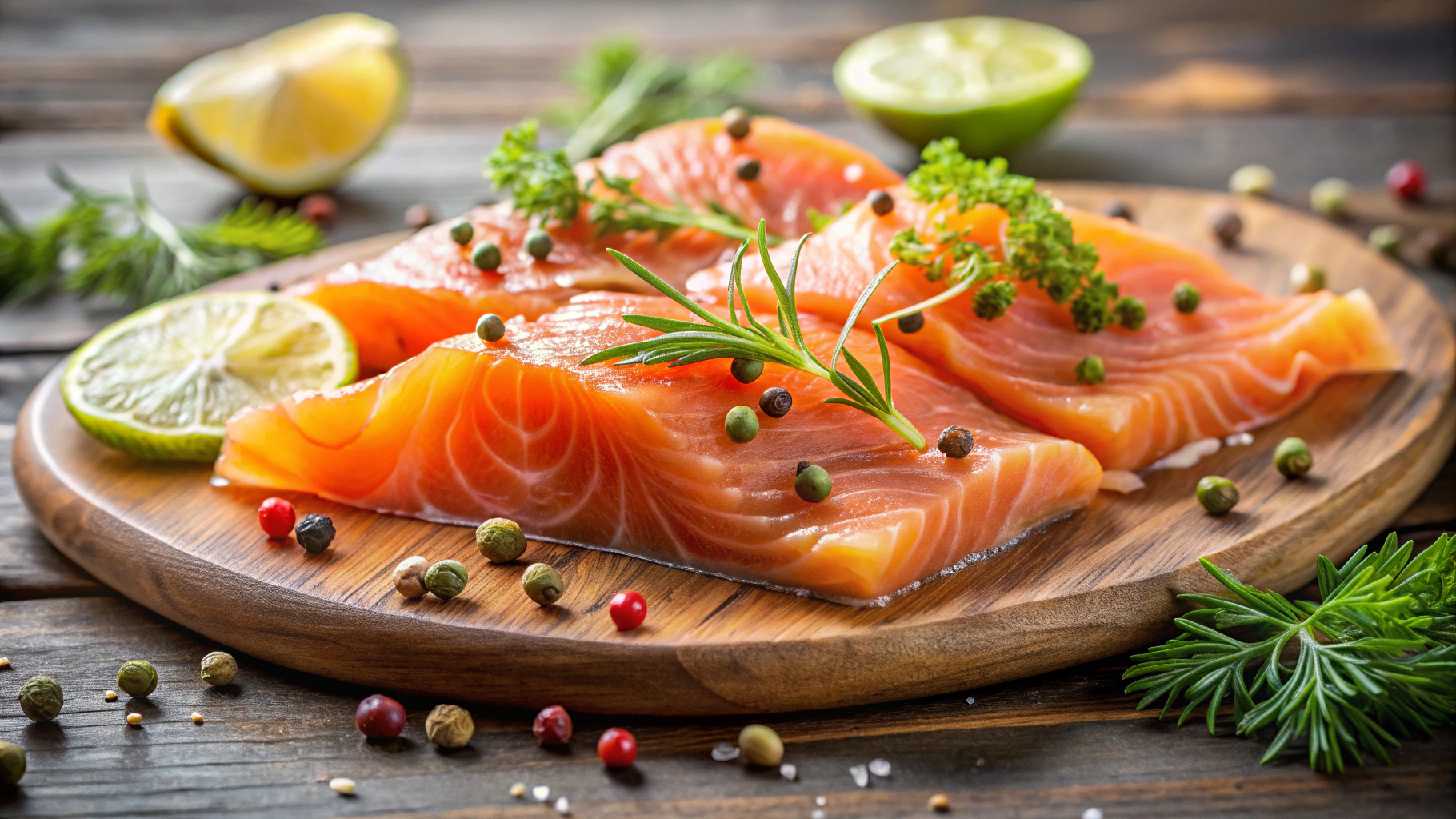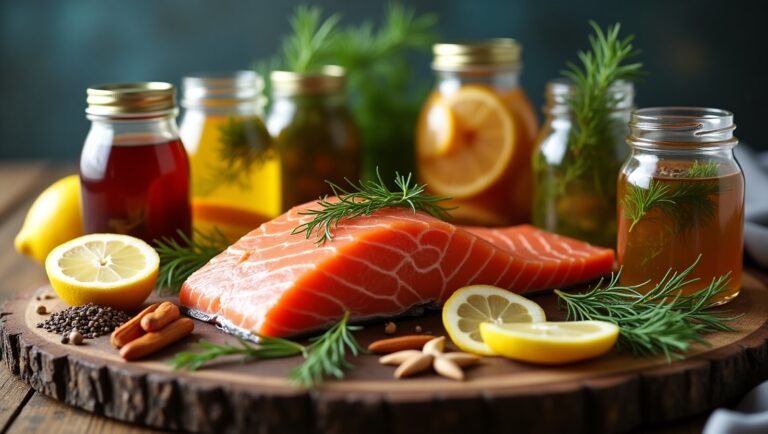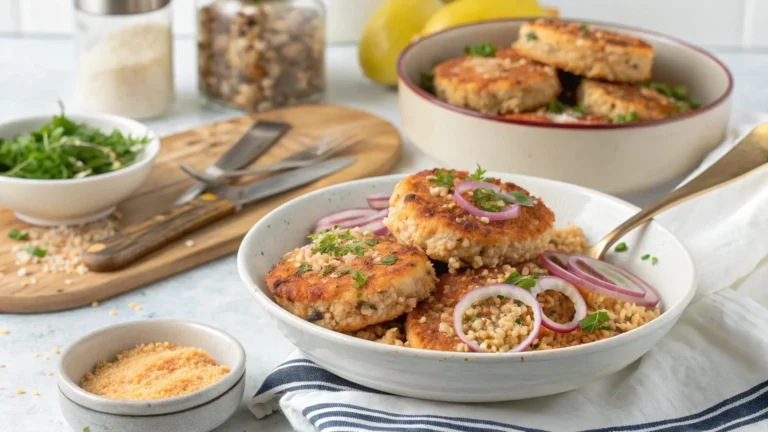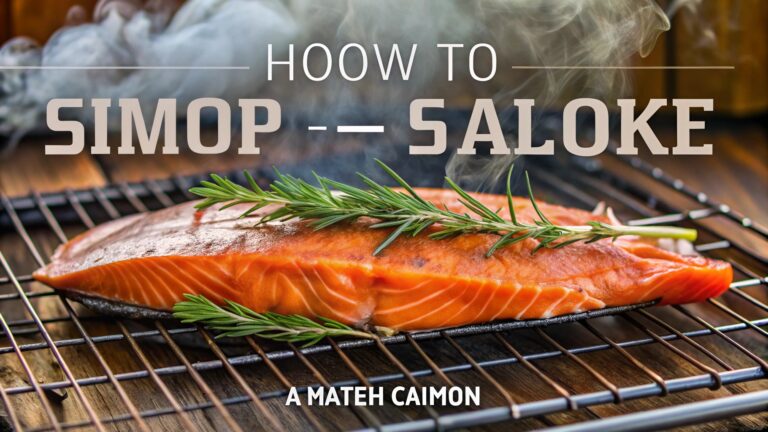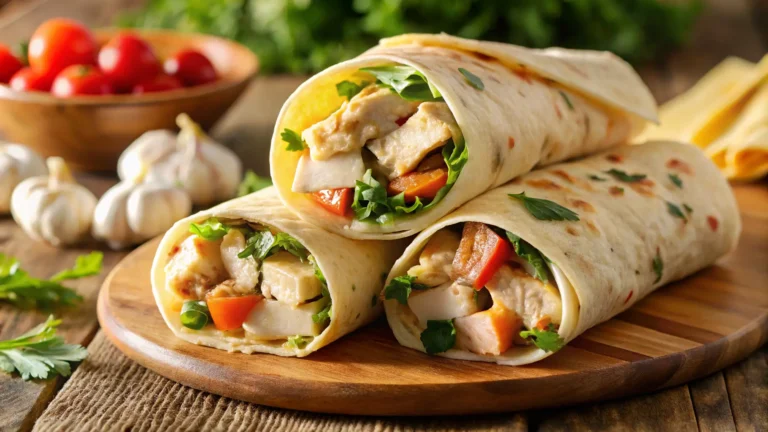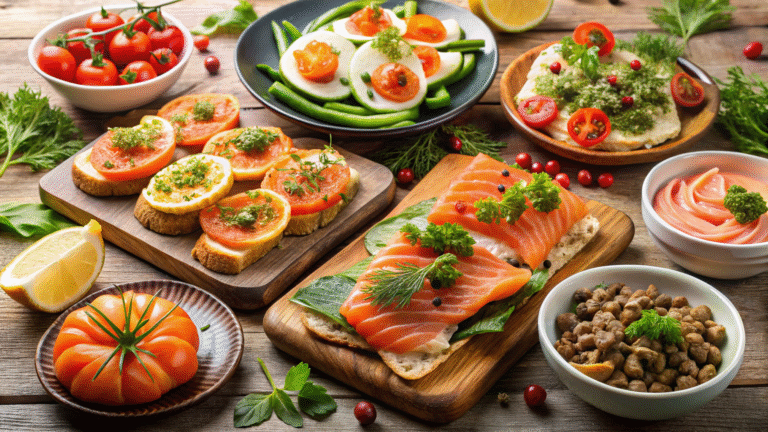Smoked Salmon Temperature: 3 Key Secrets for Perfection

Every kitchen adventure starts with passion, and mastering smoked salmon temperature is no different. I remember my first attempt at smoking salmon – a culinary journey filled with anticipation and nervous excitement. The delicate balance of heat, flavor, and technique can transform an ordinary piece of fish into a gourmet masterpiece.
Perfecting the optimal smoking temperature for salmon isn’t just about cooking; it’s about creating an experience. Whether you’re a home cook or aspiring chef, understanding smoked salmon temperature can elevate your culinary skills from good to extraordinary.
In this guide, we’ll uncover three critical secrets that will help you achieve smoky, tender, and perfectly cooked salmon every single time. These techniques will demystify the art of smoking and give you the confidence to create restaurant-quality dishes in your own kitchen.
Key Takeaways
- Temperature control is crucial for perfect smoked salmon
- Different smoking methods require unique temperature approaches
- Precision matters when smoking seafood
- Fresh salmon and proper equipment enhance smoking results
- Practice and patience lead to smoking success
Understanding Smoked Salmon and Its Cooking Process
Smoked salmon is a culinary delight that turns fresh fish into a tasty treat. It’s made through careful smoking techniques. To smoke salmon perfectly, you need to know the basics and the fine details of this traditional method.
Exploring smoked salmon opens up a world of flavors and techniques passed down through generations. The right temperature for smoking salmon is key to making a great dish.
What is Smoked Salmon?
Smoked salmon is made by curing fresh salmon and then smoking it. This method preserves the fish and adds a smoky taste that many love.
Different Types of Smoked Salmon
- Cold-Smoked Salmon: Processed at lower temperatures, maintaining a silky texture
- Hot-Smoked Salmon: Cooked at higher temperatures, resulting in a flakier consistency
- Gravlax: A Nordic variation cured with salt, sugar, and dill
The Importance of Temperature in Smoking
Temperature control is vital when smoking salmon. Each method needs precise heat to ensure safety and flavor. Experts know that small temperature changes can greatly affect taste and texture.
Whether you’re cooking at home or aiming to be a chef, mastering smoked salmon takes patience and practice. It’s about understanding how temperature, smoke, and fish quality work together.
Ideal Smoking Temperature for Salmon
Getting the smoked salmon internal temperature right is key to a tasty seafood treat. The correct temperature turns simple fish into a dish that excites your taste buds.
For the best smoked salmon, precision in temperature is essential. Different temperatures bring out unique flavors and textures, making your dish even better.
Recommended Temperature Ranges
Salmon smoking temperatures mainly fall into two ranges:
- Hot Smoking: 120°F to 180°F
- Cold Smoking: Below 90°F
Temperature’s Impact on Flavor and Texture
The temperature you choose greatly affects the taste and feel of your smoked salmon:
| Temperature Range | Flavor Profile | Texture |
|---|---|---|
| 120-140°F | Mild, delicate | Tender, flaky |
| 140-180°F | Robust, intense | Firmer, more compact |
| Below 90°F | Subtle, traditional | Silky, smooth |
“Temperature is the secret ingredient that transforms salmon from ordinary to extraordinary.” – Professional Chef
Knowing these temperature differences lets you make smoked salmon just how you like it. Try different temperatures to find your favorite style.
Cold Smoking vs. Hot Smoking
Smoking salmon is an art that requires understanding two distinct techniques: cold smoking and hot smoking. Each method brings unique characteristics to your salmon. These affect its flavor, texture, and the proper temperature for smoking salmon.
When exploring smoked salmon cooking temperature, you’ll find big differences between these two methods. Let’s look at their unique characteristics:
Cold Smoking Technique
Cold smoking is a delicate process. It preserves the salmon’s raw texture while adding rich smoky flavors. The key characteristics include:
- Temperature range: 70-90°F (21-32°C)
- Extended smoking time: 12-24 hours
- Maintains raw fish texture
- Requires curing before smoking
Hot Smoking Technique
Hot smoking transforms salmon by cooking it during the smoking process. This method offers a more thoroughly prepared dish with distinct attributes:
- Temperature range: 120-180°F (49-82°C)
- Shorter smoking time: 2-6 hours
- Fully cooked, flaky texture
- Less curing preparation required
Your choice between cold and hot smoking depends on your flavor preferences and available equipment. Cold smoking delivers a delicate, silky texture perfect for carpaccio or elegant appetizers. Hot smoking creates a heartier, more robust salmon ideal for main courses.
Pro tip: Always ensure your salmon reaches a safe internal temperature of 145°F (63°C) to prevent foodborne illnesses.
Understanding these techniques will elevate your salmon smoking skills. It will help you create restaurant-quality dishes right in your kitchen.
The Science Behind Salmon Cooking
Understanding the science of cooking salmon is key to a tasty and safe meal. The right smoker temperature is crucial for flavor and safety.
Smoking salmon is more than just cooking. It’s a science that keeps you safe and makes your food delicious. The right temperature stops bacteria from growing.
How Temperature Impacts Fish Safety
When smoking salmon, focus on two temperature zones:
- Danger Zone (40°F – 140°F): Bacteria multiply fast
- Safe Zone (Above 145°F): Kills harmful bacteria
Ideal Internal Temperature for Consuming Salmon
To ensure food safety, salmon must reach an internal temperature of 145°F. This temperature:
- Kills harmful bacteria
- Makes proteins perfect
- Keeps moisture and flavor
“Precision in temperature is the secret to perfect smoked salmon” – Professional Chef Recommendation
Always check the Smoked Salmon Temperature with a meat thermometer. Your health and cooking success depend on it.
Preparing Your Smoked Salmon
Making perfect smoked salmon needs careful prep and attention. Knowing how to pick the right ingredients and use the right techniques is key. This will help you get a great result when smoking salmon.
Selecting High-Quality Salmon
Choosing the freshest fish is key for smoking salmon. Look for salmon with these qualities:
- Bright, clear eyes
- Firm flesh with no discoloration
- Fresh, clean ocean smell
- Vibrant pink or orange color
Essential Smoking Equipment
To smoke salmon well, you need the right equipment. It helps keep the temperature steady and the quality high:
| Equipment | Purpose |
|---|---|
| Digital meat thermometer | Monitor internal fish temperature |
| Smoker or pellet grill | Controlled smoking environment |
| Cooling rack | Allow proper air circulation |
| Sharp fillet knife | Prepare salmon for smoking |
Marinades and Brines for Enhanced Flavor
Marinades and brines are vital for smoking salmon. A classic brine keeps moisture in and adds flavor. Here are some ingredients to consider:
- Salt: Draws out moisture and seasons the fish
- Brown sugar: Balances saltiness and creates caramelization
- Herbs: Dill, thyme, or rosemary for aromatic complexity
- Citrus zest: Adds bright, fresh notes
Try different mixes to find your own smoked salmon recipe. This way, you can keep the ideal smoking temperature for salmon.
Monitoring Temperature During Smoking
To get perfect smoked salmon, you need to control the temperature well. You must track the smoker’s temperature and the fish’s internal temperature. Professional smokers say that keeping an eye on these is key to making delicious, safe salmon.

Choosing the Right Meat Thermometer
Choosing the right meat thermometer is very important. You want one that gives accurate readings. Look for thermometers that are:
- Fast
- Accurate
- Good for seafood
- Waterproof
Proper Temperature Measurement Technique
To check the salmon’s temperature, put the thermometer probe into the thickest part. Avoid touching bones or the smoker’s surface. The salmon should be at 145°F (63°C) for it to be safe to eat.
Knowing When to Remove Salmon from Heat
Here’s when you know your salmon is done:
- Internal temperature hits 145°F
- Flesh looks opaque and flakes easily
- It feels firm but is still moist
“Patience and precision are the secrets to exceptional smoked salmon.” – Culinary Experts
After taking the salmon out of the heat, let it rest for a bit. This helps the temperature even out and makes the flavor better.
Post-Smoking Temperature Considerations
After you’ve found the perfect smoking temp for salmon, your work isn’t done. Cooling, storing, and reheating are key to keep the flavor and texture right. This ensures your smoked salmon stays delicious.
Smoking salmon isn’t just about the initial cooking. After it’s smoked, follow these steps to keep it fresh:
Cooling Your Smoked Salmon
- Let the salmon cool at room temperature for 15-20 minutes
- Place it on a clean, non-reactive surface
- Don’t cover it right away to avoid moisture
Safe Storage Techniques
Storing your smoked salmon right is important for its quality and taste:
- Wrap it tightly in plastic wrap or vacuum-seal
- Keep it in the fridge at 38-40°F (3-4°C)
- Eat it within 3-5 days for the best flavor
Reheating Without Losing Flavor
When reheating smoked salmon, be gentle to keep it tender:
- Use low heat, around 275°F
- Cover with foil to keep it moist
- Heat it just until it’s warm (about 10 minutes)
- Pro tip: Don’t use the microwave, as it can make it tough
Remember, controlling the temperature is crucial for enjoying perfectly smoked salmon from start to finish!
Flavor Enhancements Through Temperature Control
Mastering smoked salmon is more than basic cooking. The right temperature can turn a simple dish into a masterpiece. Temperature control is key to rich, complex flavors that excite your taste buds.
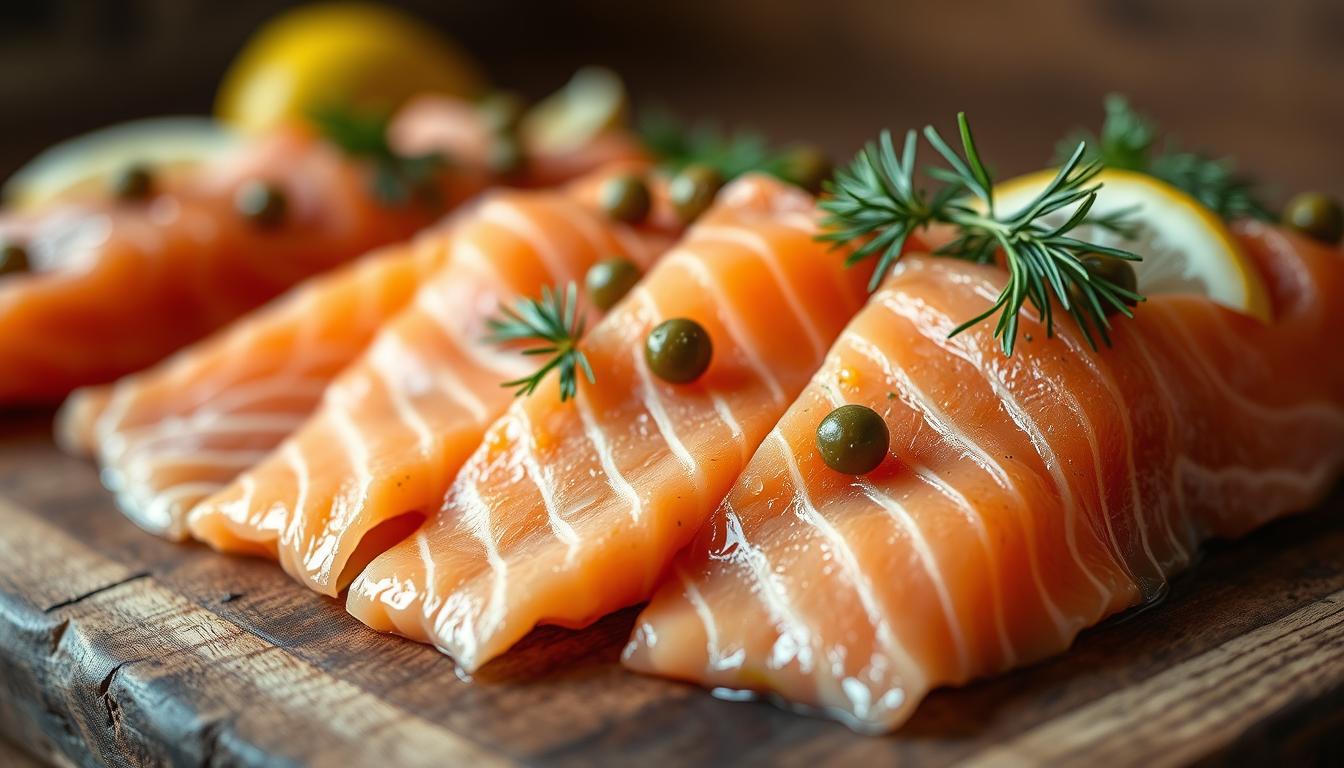
Wood chips are essential for enhancing flavors. Different woods react differently with temperature, creating unique tastes:
- Alder Wood: Mild, delicate flavor best at lower temperatures (175-200°F)
- Apple Wood: Sweet, fruity notes ideal for medium-range temperatures (200-225°F)
- Hickory Wood: Strong, bold flavor works well at higher temperatures (225-250°F)
Flavor Infusion Techniques
Your smoking method greatly affects flavor. Lower temperatures allow for slow flavor absorption. Higher temperatures bring out more intense tastes. Try temperatures between 175-250°F to find your favorite salmon flavor.
Strategic Temperature Management
Professional smokers know temperature is about more than cooking. It’s about creating a memorable taste experience. By controlling your smoker’s temperature, you can build layers of flavor. This ensures each salmon bite is a delicious story.
Serving Suggestions for Smoked Salmon
After perfecting your smoked salmon temperature, it’s time to think about presentation and pairing. The right sides can turn your smoked salmon into a true masterpiece.
The temperature you use to smoke salmon affects its texture and taste. So, it’s important to pick ingredients that bring out its best.
Classic Accompaniments
- Cream cheese on bagels
- Capers and red onion
- Dill and lemon wedges
- Cucumber rounds
Creative Presentation Ideas
Make your smoked salmon into fancy appetizers or big meals with these ideas:
- Salmon tartare on crisp crostini
- Rolled smoked salmon pinwheels
- Salmon-topped salad with citrus vinaigrette
| Occasion | Recommended Presentation |
|---|---|
| Casual Brunch | Open-faced sandwiches |
| Dinner Party | Plated salmon rosettes |
| Cocktail Event | Mini salmon canapés |
Remember, the smoked salmon temperature you choose will affect its look and taste. Try different ways to serve it and find what you like best.
Troubleshooting Common Mistakes
Learning to smoke salmon perfectly means knowing how to fix common problems. Even skilled cooks can face issues. But, with the right tips, you can make your smoked salmon taste like it’s from a restaurant.
Identifying Smoking Temperature Challenges
Finding the right temperature for smoking salmon is key. Wrong temperatures can cause:
- Dry, tough fish texture
- Uneven cooking
- Potential food safety risks
Overcoming Overcooking and Undercooking
To avoid overcooking or undercooking, follow these expert tips:
- Use a reliable meat thermometer
- Monitor internal temperature carefully
- Remove salmon when it reaches 145°F internal temperature
| Common Issue | Solution |
|---|---|
| Dry Salmon | Lower smoking temperature, reduce cooking time |
| Undercooked Salmon | Increase temperature slightly, ensure consistent heat |
| Bitter Taste | Choose mild wood chips, avoid over-smoking |
“Precision is the key to perfect smoked salmon.” – Professional Chef
Pro tip: Always let salmon rest for 5-10 minutes after smoking. This lets juices redistribute, making it moist and flavorful.
Achieving the Perfect Smoked Finish
Smoking salmon well takes patience and practice. Focus on temperature, use top-notch ingredients, and try different methods. This will help you find your ideal way to smoke salmon.
Conclusion and Final Tips for Perfect Smoked Salmon
Getting perfect smoked salmon is all about mastering technique and temperature control. Knowing the right smoking temperature and keeping the internal temperature just right is key. These tips will turn your kitchen into a gourmet seafood haven.
Temperature is crucial for delicious smoked salmon. With the right heat, you’ll get fish that’s tender, tasty, and safe to eat. Whether you’re cold or hot smoking, keeping the temperature steady is essential.
Don’t be afraid to try new wood chips, marinades, and smoking methods. Each try will improve your skills and show you how temperature affects salmon’s taste and texture. Start simple, track your progress, and grow more confident in your smoking.
Practice is the key to becoming a smoked salmon pro. Start by learning these basic temperature tips. Keep exploring, stay curious, and enjoy the tasty outcomes of your new smoking skills.

